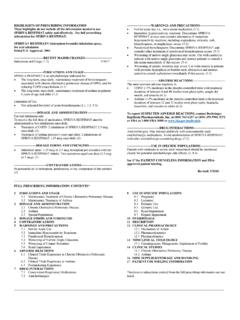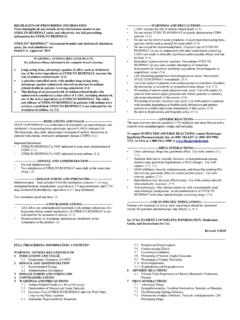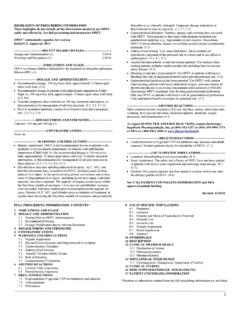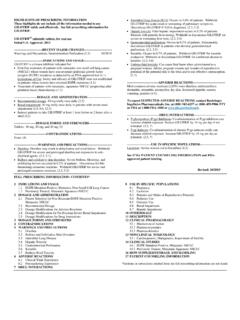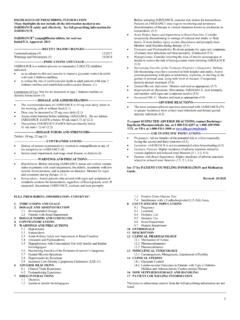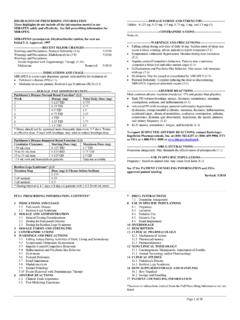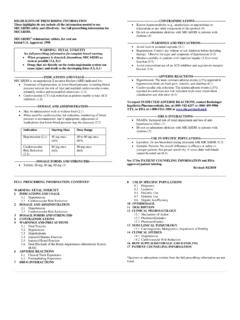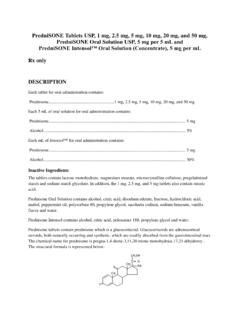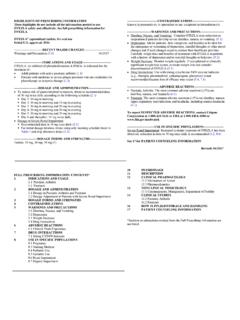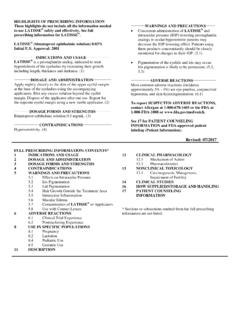Transcription of HIGHLIGHTS OF PRESCRIBING INFORMATION o …
1 HIGHLIGHTS OF PRESCRIBING INFORMATION These HIGHLIGHTS do not include all the INFORMATION needed to use PRADAXA safely and effectively. See full PRESCRIBING INFORMATION for PRADAXA. PRADAXA (dabigatran etexilate mesylate) capsules, for oral use Initial Approval: 2010 WARNING: (A) PREMATURE DISCONTINUATION OF PRADAXA INCREASES THE RISK OF THROMBOTIC EVENTS, and (B) SPINAL/EPIDURAL HEMATOMA See full PRESCRIBING INFORMATION for complete boxed warning (A) PREMATURE DISCONTINUATION OF PRADAXA INCREASES THE RISK OF THROMBOTIC EVENTS: Premature discontinuation of any oral anticoagulant, including PRADAXA, increases the risk of thrombotic events.
2 To reduce this risk, consider coverage with another anticoagulant if PRADAXA is discontinued for a reason other than pathological bleeding or completion of a course of therapy ( , , , ). (B) SPINAL/EPIDURAL HEMATOMA: Epidural or spinal hematomas may occur in patients treated with PRADAXA who are receiving neuraxial anesthesia or undergoing spinal puncture. These hematomas may result in long-term or permanent paralysis ( ). Monitor patients frequently for signs and symptoms of neurological impairment and if observed, treat urgently. Consider the benefits and risks before neuraxial intervention in patients who are or who need to be anticoagulated ( ).
3 ----------------------------INDICATIONS AND USAGE--------------------------- PRADAXA is a direct thrombin inhibitor indicated: To reduce the risk of stroke and systemic embolism in patients with non-valvular atrial fibrillation ( ) For the treatment of deep venous thrombosis (DVT) and pulmonary embolism (PE) in patients who have been treated with a parenteral anticoagulant for 5-10 days ( ) To reduce the risk of recurrence of DVT and PE in patients who have been previously treated ( ) For the prophylaxis of DVT and PE in patients who have undergone hip replacement surgery ( )
4 ----------------------DOSAGE AND ADMINISTRATION----------------------- Non-valvular Atrial Fibrillation: o For patients with CrCl >30 mL/min: 150 mg orally, twice daily ( ) o For patients with CrCl 15-30 mL/min: 75 mg orally, twice daily ( ) Treatment of DVT and PE: o For patients with CrCl >30 mL/min: 150 mg orally, twice daily after 5-10 days of parenteral anticoagulation ( ) Reduction in the Risk of Recurrence of DVT and PE: o For patients with CrCl >30 mL/min: 150 mg orally, twice daily after previous treatment ( ) Prophylaxis of DVT and PE Following Hip Replacement Surgery: o For patients with CrCl >30 mL/min: 110 mg orally first day, then 220 mg once daily ( ) Review recommendations for converting to or from other oral or parenteral anticoagulants ( , ) Temporarily discontinue PRADAXA before invasive or surgical procedures when possible, then restart promptly ( ) ---------------------DOSAGE FORMS AND STRENGTHS---------------------- Capsules.
5 75 mg, 110 mg and 150 mg (3) -------------------------------CONTRAIND ICATIONS------------------------------ Active pathological bleeding (4) History of serious hypersensitivity reaction to PRADAXA (4) Mechanical prosthetic heart valve (4) -----------------------WARNINGS AND PRECAUTIONS------------------------ Bleeding: PRADAXA can cause serious and fatal bleeding ( ) Bioprosthetic heart valves: PRADAXA use not recommended ( ) ------------------------------ADVERSE REACTIONS------------------------------- Most common adverse reactions (>15%) are gastritis-like symptoms and bleeding ( ) To report SUSPECTED ADVERSE REACTIONS, contact Boehringer Ingelheim Pharmaceuticals, Inc.
6 At (800) 542-6257 or (800) 459-9906 TTY or FDA at 1-800-FDA-1088 or -------------------------------DRUG INTERACTIONS---------------------------- -- P-gp inducers rifampin: Avoid coadministration with PRADAXA ( ) P-gp inhibitors in patients with CrCl 30-50 mL/min: Reduce dose or avoid (7) P-gp inhibitors in patients with CrCl <30 mL/min: Not recommended (7) -----------------------USE IN SPECIFIC POPULATIONS------------------------ Lactation: Breastfeeding not recommended. ( ) Geriatric use: Risk of bleeding increases with age ( ) See 17 for PATIENT COUNSELING INFORMATION and Medication Guide.
7 Revised: 03/2018 _____ FULL PRESCRIBING INFORMATION : CONTENTS* WARNING: (A) PREMATURE DISCONTINUATION OF PRADAXA INCREASES THE RISK OF THROMBOTIC EVENTS, and (B) SPINAL/EPIDURAL HEMATOMA 1 INDICATIONS AND USAGE Reduction of Risk of Stroke and Systemic Embolism in Non-valvular Atrial Fibrillation Treatment of Deep Venous Thrombosis and Pulmonary Embolism Reduction in the Risk of Recurrence of Deep Venous Thrombosis and Pulmonary Embolism Prophylaxis of Deep Vein Thrombosis and Pulmonary Embolism Following Hip Replacement Surgery 2 DOSAGE AND ADMINISTRATION Recommended Dose Dosing Adjustments Instructions to Patients Converting from or to Warfarin Converting from or to Parenteral Anticoagulants
8 Discontinuation for Surgery and Other Interventions 3 DOSAGE FORMS AND STRENGTHS 4 CONTRAINDICATIONS 5 WARNINGS AND PRECAUTIONS Increased Risk of Thrombotic Events after Premature Discontinuation Risk of Bleeding Spinal/Epidural Anesthesia or Puncture Thromboembolic and Bleeding Events in Patients with Prosthetic Heart Valves Effect of P-gp Inducers and Inhibitors on Dabigatran Exposure 6 ADVERSE REACTIONS Clinical Trials Experience Postmarketing Experience 7 DRUG INTERACTIONS Reduction of Risk of Stroke and Systemic Embolism in Non-valvular Atrial Fibrillation Treatment and Reduction in the Risk of Recurrence of Deep Venous Thrombosis and Pulmonary Embolism Prophylaxis of Deep Vein Thrombosis and Pulmonary Embolism Following Hip Replacement Surgery 8 USE IN SPECIFIC POPULATIONS Pregnancy Lactation Pediatric Use Geriatric Use Renal Impairment 10 OVERDOSAGE 11 DESCRIPTION 12 CLINICAL PHARMACOLOGY Mechanism of Action Pharmacodynamics Pharmacokinetics 13 NONCLINICAL TOXICOLOGY
9 Carcinogenesis, Mutagenesis, Impairment of Fertility 14 CLINICAL STUDIES Reduction of Risk of Stroke and Systemic Embolism in Non-valvular Atrial Fibrillation Treatment and Reduction in the Risk of Recurrence of Deep Venous Thrombosis and Pulmonary Embolism Prophylaxis of Deep Vein Thrombosis and Pulmonary Embolism Following Hip Replacement Surgery 16 HOW SUPPLIED/STORAGE AND HANDLING 17 PATIENT COUNSELING INFORMATION Instructions for Patients Bleeding Gastrointestinal Adverse Reactions Invasive or Surgical Procedures Concomitant
10 Medications Prosthetic Heart Valves Pregnancy Lactation *Sections or subsections omitted from the full PRESCRIBING INFORMATION are not listed. FULL PRESCRIBING INFORMATION WARNING: (A) PREMATURE DISCONTINUATION OF PRADAXA INCREASES THE RISK OF THROMBOTIC EVENTS, and (B) SPINAL/EPIDURAL HEMATOMA (A) PREMATURE DISCONTINUATION OF PRADAXA INCREASES THE RISK OF THROMBOTIC EVENTS Premature discontinuation of any oral anticoagulant, including PRADAXA, increases the risk of thrombotic events. If anticoagulation with PRADAXA is discontinued for a reason other than pathological bleeding or completion of a course of therapy, consider coverage with another anticoagulant [see Dosage and Administration ( , , ) and Warnings and Precautions ( )].
